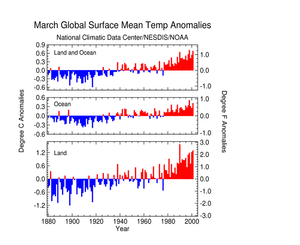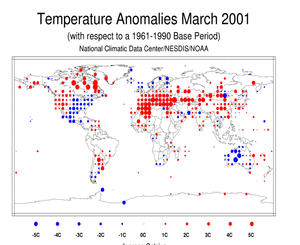 larger image |
Temperature
| The land and ocean
combined temperature averaged across the globe was 0.68C (1.22F)
above the 1880-2000 long-term mean in March. This was the second
warmest March on record since reliable measurements began in 1880,
and was second only to March 1998 when the combined land and ocean
temperature anomaly was 0.71C (1.28F). Ocean surface temperatures
were also the second warmest on record [0.41C (0.74F) above
average], which was 0.10C (0.18F) cooler than during the El Nino
episode of 1998. Temperatures averaged over land surfaces were
1.29C (2.32F) above average, the second warmest March on record,
but 0.28C (0.50F) cooler than the record March land temperature set
in 1990. Although surface temperatures were warm, the temperatures above the surface were less anomalous. Temperatures in the lowest 8km of the troposphere were just 0.01C (0.02F) above the long term average when compared to data recorded since 1979. Lower tropospheric temperatures in the Southern Hemisphere were 0.13C (0.23F) cooler than average while temperatures in the Northern Hemisphere were 0.15C (0.27F) warmer than average. In the lower stratosphere, the global temperature was 0.53C (0.95F) cooler than the average, which ranked as the second coolest March during the satellite period of record which began in 1979. Both the Northern and Southern Hemispheric temperatures were also below the average, with negative departures of 0.58C (1.0F) and 0.48C (0.86F), respectively. Lower tropospheric and lower stratospheric temperature data are collected by NOAA's TIROS-N polar-orbiting satellites and adjusted for time-dependent biases by NASA and the Global Hydrology and Climate Center at the University of Alabama in Huntsville. |
| While still above the long term average, sea surface temperatures in the tropics were suppressed by the continuation of weak La Nina conditions with smaller positive anomalies (0.35C/0.63F) observed between latitudes 20N to 20S. Temperatures in the extratropics were notably warmer. Northern Hemisphere oceans north of 20N ranked as 5th warmest while in the Southern Hemisphere south of 20S, sea surface temperatures were 2nd warmest. |  larger image |
| Across land areas, anomalies were only slightly positive in the tropics, while extratropical regions of the Northern Hemisphere experienced the third warmest March with positive anomalies of 1.89C (3.40F). South of 20S, positive temperature anomalies on the order of 0.46C (0.83F) were noted, but these departures were not among the top ten warmest on record. |  larger image |
 larger image |
Above average temperatures were observed across western and northern North America, with upper level ridging at high latitudes responsible for anomalous warmth across northern and eastern Canada. Departures from the mean ranged from 2 to 5C ( 3.6 to 9F) in these regions. Other significant positive anomalies were located over Argentina. A very large area of much above normal warmth covered nearly all of southern Europe into north Africa and eastward across parts of the former Soviet Union. Positive temperature departures were on the order of 4 to 6C (7.2 to 10.8F) across a wide area as a warm upper ridge of high pressure dominated the region. Anomalously colder weather was confined to eastern areas of the United States, Scandinavia and central Australia. |
Precipitation
| Heavier than normal precipitation fell across much of western and central Europe where precipitation surpluses of 100-200mm (3.9 to 7.9 inches) were common. Southeast Asia and Indonesia experienced wetter-than-average conditions, as well as portions of Western Australia and the Northern Territory. In South America, wet weather persisted across parts of Peru and Bolivia, with beneficial rains over agricultural areas of Argentina as reported by the Joint Agricultural Weather Facility. Drier than average conditions were observed over northern South America, including Venezuela to northern Brazil. Across Afghanistan and Pakistan, negative precipitation anomalies continued long-term drought conditions that were adversely affecting those countries. Drought conditions in portions of Queensland in Australia improved little in March as dry weather prevailed. |  larger image |
For additional details on precipitation and temperatures in March see the Global Regional page .
References:
Peterson, T.C. and R.S. Vose, 1997: An Overview of the Global
Historical Climatology Network Database. Bull. Amer. Meteorol.
Soc., 78, 2837-2849.
 NOAA's National Centers for Environmental Information
NOAA's National Centers for Environmental Information